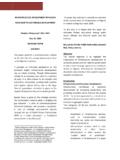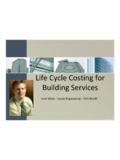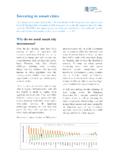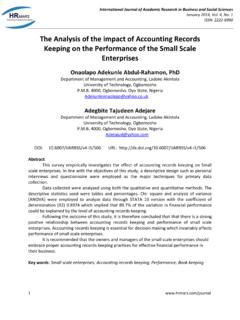Transcription of Benefit-Cost Analysis for Risk Management - World Bank
1 Background Paper Benefit-Cost Analysis for Risk Management : Summary of Selected Examples Kyla Wethli The World bank Benefit-Cost Analysis for Risk Management : Summary of Selected Examples Background paper for the World Development Report 2014 Kyla Wethli, World bank Introduction When preparation for risk is poor, or unexpectedly large shocks overwhelm what preparation is in place, the consequences can be devastating. Whether shocks are idiosyncratic or systemic, shocks such as illness, loss of employment, crime, economic crises and natural hazards can cause substantial distress, have large economic costs, and lead to loss of life.
2 Crises are costly. But the measures required to better prepare for shocks are also costly, while the benefits given people don t know which shocks will occur or when are often uncertain. So households, firms and policy makers face the question: does it pay off to prepare for possible losses? Or is it better to face the consequences if and when a risk materializes? Benefit-Cost analyses provide one means of trying to evaluate these questions. Weighing benefits against costs At the center of any cost -effectiveness calculation are estimates of the likely costs and benefits of an intervention. Many studies attempt to calculate the total cost of an intervention by estimating the direct costs of an intervention in a particular area and then extrapolating across time or geographical area.
3 These cost estimates are then compared to the benefits of preparation should a shock occur. The direct benefits of preparation usually include averted loss of life or disability, and averted material damages. Some indirect benefits such as improved productivity when illness is averted may also be relevant, but most studies focus more narrowly on direct benefits Many studies provide a range of estimates, based on more pessimistic (or optimistic) assumptions. Whether an intervention is ultimately considered cost -effective depends on several other factors most notably, the probability of a shock occurring.
4 Intuitively, large shocks that are very likely to occur are the ones for which preparation is most Some studies estimate the costs that 1 See, for example, Ozawa and others 2012 for a systematic review of the cost -effectiveness of vaccination, which includes a discussion on the proportion of studies that consider direct versus indirect benefits of vaccination. Poulos and others 2004 show how taking social costs and benefits into account (over and above public sector costs and savings alone) can substantially change conclusions about whether given programs are cost -effective.
5 2 By contrast, low-probability high-impact events are potentially the most difficult to evaluate. An intervention may be cost -effective on average because it is highly beneficial when high-impact events do risk Management can help to avert based on the average annual cost of a given shock historically (including average number of lives lost per year and so on). By rooting their calculations in average historical data, these studies implicitly take into account how frequently shocks occur. Other studies take the probability of shocks into account more explicitly comparing the actual cost of an intervention to the potential benefit should a shock occur, weighted by the probability of that shock occurring.
6 In studies that take this approach, interventions typically appear more cost -effective as the time horizon is lengthened and the occurrence of shocks thus become more likely. It is thus appropriate for the time horizon of Benefit-Cost analyses to match the time horizon of the intervention in question; otherwise the benefits are likely to be underestimated. Authors choices for key parameters can also affect cost -effectiveness Perhaps most importantly, authors must decide on what value to place on an averted death. The Copenhagen Consensus provides a benchmark for the value of averted death that is used in several of the studies discussed below.
7 The agreed Copenhagen Consensus for the value of human life per disability-adjusted life year (DALY) is between $1000 and $5000. Depending on authors assumptions about life-expectancy, this would translate to value of an averted death at mid-life between $35,000 and $175,000; the value an averted death of a child would be higher. Since the benefits from risk Management accrue in the future, while the costs are often predominantly upfront, authors of Benefit-Cost analyses must also make a choice of what discount rate to use to weigh (or discount) future costs and benefits .
8 In economic theory, this discount rate reflects how an individual might value consumption today compared to consumption in the future. There is considerable debate, however, about what values to assign the discount rate in Many authors thus provide different sets of calculations corresponding to a variety of values for the discount rate. There are a number of other factors that could influence whether a particular project makes sense to a particular decision maker including how risk averse they are, whether they are credit constrained, the likely distributional impact of a project, or the political context in which risk Management decisions must be considered.
9 However, such factors are typically not taken into account in most Benefit-Cost This underscores a fundamental tension of Benefit-Cost analyses: while they occur, even if it is not cost -effective for most no or low-impact scenarios. See Ghesquiere, Jamin and Mahul 2006 for an illustrative discussion in the case of earthquakes in Colombia. 3 See Kenny 2012 for a thorough discussion of how variations in underlying assumptions can influence the results of Benefit-Cost Analysis .
10 4 For policies that have inter- (as well as intra-) generational effects, there is also a debate about whether the value of the discount rate should decline over time, to reflect increasing uncertainty about costs and benefits that affect generations further out in the future. See Arrow and others 2012 for a full discussion. 5 The Arrow-Lind Theorem demonstrates that risk aversion can be safely ignored for public investment projects under certain conditions. These conditions are that: (i) the government initially pays all costs and appropriates all benefits (thereafter distributing net benefits through tax policy), (ii) the net benefits are statistically independent from individuals income in the absence of a project, and (iii) the net benefits of a may be necessary to improved decision making that carefully articulates potential benefits and costs, they may not be a sufficient basis for policy decisions.

















